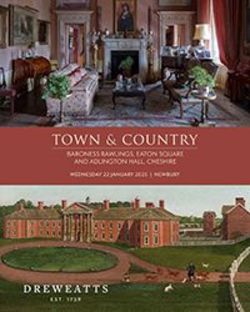λ LYNN CHADWICK (BRITISH 1914-2003)
MAQUETTE FOR THE TRIGONS
Bronze
Numbered 338 B 0/6 (to underside)
Height (including base): 34cm (13¼ in.)
Conceived in 1961 as one of a three part sculpture.
Provenance:
Sale, Christie's, New York, 7 November 2000, lot 174
Acquired from the above by Baroness Rawlings
Literature:
D. Farr and E. Chadwick, Lynn Chadwick, Sculptor: With a Complete Illustrated Catalogue 1947-2003 , Farnham, 2014, p. 192, no. 338, illustration of another cast
The Maquette for the Trigons consists of three stacked angular forms supported by a three-pointed base. This distinctive base embodies the title of the work, Trigon , derived from the ancient term for triangle. Chadwick created several maquettes in the Trigon series, experimenting with varying proportions and surface finishes, all unified by the iconic three-point structure. His sculptures explore the dynamic interplay of strong, angular, and compact forms, imbued with a sense of energy. Chadwick's figures are abstracted into geometric shapes-rectangular heads, spiky legs, and bulky torsos-evoking aspects of the human body while deliberately avoiding the individualized or representational qualities typical of traditional portraiture.
The Trigon series reflects Chadwick's fascination with monolithic human forms, particularly the Moai statues of Easter Island. In 1963, a large-scale version of Trigon was acquired by Maurice Ash, chairman of the Town and Country Planning Association, on behalf of the Harlow Art Trust and currently on display in Harlow town centre.
Chadwick's career gained momentum during the 1950s, securing his reputation as one of Britain's leading sculptors. He first exhibited in 1950 at the Gimpel Fils gallery in London alongside Kenneth Armitage, also featured in the auction (lot 27 & 64) and Reg Butler. The following year, he was commissioned to create three works for the Festival of Britain, including Cypress , a mobile sculpture crafted in metal. His international acclaim was solidified in 1956 when he won the International Sculpture Prize at the Venice Biennale, followed by exhibitions in 1957 at the Saidenberg Gallery in New York.
The Maquette for the Trigons was created shortly after Chadwick moved to Lypiatt Park, a medieval manor house which he transformed into a permanent exhibition space for his art, ranging from monumental bronzes to his iconic maquettes. In 1972, Chadwick established his own foundry at Lypiatt Park and later collaborated with Pangolin Editions for the casting of his bronzes.
' Art must be the manifestation of some vital force coming from the dark, caught by the imagination and translated by the artist's ability and skill ... Whatever the final shape, the force behind ... indivisible. When we philosophise upon this force we lose sight of it. The intellect alone is too clumsy to grasp it , ' A. Bowness, Lynn Chadwick , London, 1962
Condition Report:
There is a build up of dirt and verdigris to crevasses throughout and the work would benefit from a professional clean. Otherwise, in good overall condition.
Condition Report Disclaimer
















